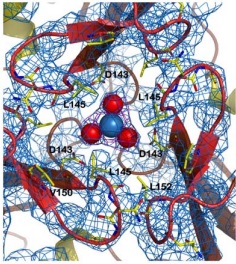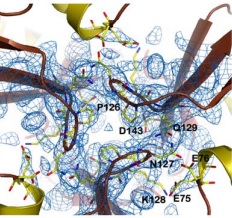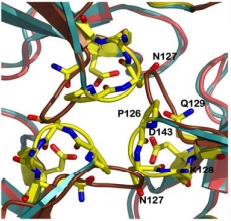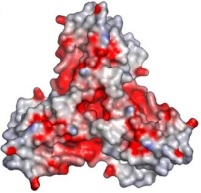Function and Structural highlights
General Aspects
Frataxin is a protein capable of storing, releasing and detoxifying intracellular iron. In humans, a mutation in this protein can trigger the Friedreich's ataxia, a neurodegenerative disease caused due to incapacity to form iron-sulfur groups necessary to activate the mitochondrial enzyme involved in the electron transportation chain, aconitase.
It consists of a polymeric molecule that, altought capable of forming larger complexes (as the 24 subunit oligomer detected by electron microscopy), exerts its activity by association of three subunits, enough to form a central channel where the ferroxidation takes place.
In the following paragraphs, we describe the general features of its structure in the trimeric form as obtaneid by X-ray cristallography at 3Å resolution. The protein used was obtained from the Y37A yeast, which has a 40% sequence identity to the human frataxin.
In the box at the right, it is possible to see its in a space-fill model, in which violet, orange and light-green represent, each, a different monomer from the entire molecule.
However, to cover some important aspects of the structure and function of the molecule, it is particularly useful to represent its .
General Secondary and Tertiary Structure Patterns
The is basically composed of two alpha-helices (in red) and a short helical segment (in magenta), and seven antiparallel beta-sheets, in each monomer, represented here as six green setae and one short region colored yellow. Turns and coils are also represented.
You can also view the monomer isolated .
From the (blue represents the N-terminus, while red the C-terminus), in the monomer, the short helical segment called goes from Leu 68 to Gln 63, ranges from Glu 93 to Glu 76, while goes from Leu 171 to Ser 158 (in yellow).
The sequences comprising each beta-sheet (in purple) are the following: Pro 100-Ser 105 for , Val 108-Ile 113 for , Gln 124-Gly 117 for , Ser 134-Gln 129 for , Asp 143-Gly 138 for , Trp 149-Leu 152 for and the short region between Lys 157-Gly 155 for .
Concerning the tertiary structure, each subunit has a folding pattern called α/β sandwich, in wich two alpha-helices are packed against five strands of antiparallel beta-sheets. to see it in the whole trimeric form.
Stabilization of the Trimeric Quaternary Structure
The trimeric structure of frataxin consists of the association of three monomers, and is mainly stabilized by the of each subunit, shown in yellow. These consist of loops, with a short helical N-terminal segment (alpha-helix 1; recall its secondary structure) highly flexible in the monomer solution, but interestingly, when in the trimeric arragement, they play a crucial role in mantaining it. Viewing of the molecule, we can notice how the N-terminal extensions, still in yellow, interact with the adjacent monomer. Taking a , it is possible figure out how the N-terminal loop of the first monomer, here described as chain A, is placed with respect to chain B.
the details, it is possible to see some residues close enough to interact. The names associated with their positions can be seen by .
to rotate this region. We can the residues differently according to their hydrophilicity. In this new color scheme, polar residues are represented in pink while the hydrophobic ones appear gray. Now we are about to all those relevant residues to specify their interactions. The can be seen. Here, Pro 62, Val 65 and Leu 68, shown in dark-blue, are packed against the polar uncharged aminoacids Thr 110 and Thr 118, in red (other aminoacids are shown in turquoise). This interaction among the hydrophobic residues contributes to the maneintance of the loop configuration of the N-terminal region at its extremity. Another important interaction is the formed between Glu 64 and Thr 118. Those are the only residues able to form hydrogen bond, since the is within a range of approximately 3 Å (or 0.3 nm). , pay special attention it the role of the carbonyl oxygen of Glu 64 involved in the hydrogen bonding. In this color scheme, carbons are grey, oxygens are red and nitrogens are blue.
Now, we can devote our attention to examine what occurs at the .Those are the in relevant interactions that contribute to the stabilization of the trimeric form. Those are their specific (different colors of the labels simply indicates different subunits). to give emphasis on them, and to get a better spatial notion of its arrangement.
If we (recall: pink for charged aminoacids, and grey for aliphatic ones), it becomes evident their charged nature. Them, there is no hydrophobic packing taking place at this region. Instead, there are hydrogen bonds as the main eletrostatic interaction. Notice, again, the of each aminoacid: in this color scheme, again, we have C, O, and N.
There are six hydrogen-bonding pairs contributing to the stabilization of the molecule. Between , and , the pair is always formed between the carbonyls of the first and the amide groups of the second.
The other type of hydrogen bonding occurs between the side chains of the aminoacids involved in the pairs , and . In any of each ways, there is always an oxygen and a nitrogen involved.
The Role of the Channel
The channel of the trimer is formed at its 3-fold axis, in a central position. It is the strure responsible for stabilizing the atom of iron for delivery, but also acts to further stabilise the trimeric form.
Stabilising one side of the channel, there are some interactions between the , which form a helic structure maintened, for instance, through hydrogen bonds between the pairs and . this last one also estabilizes the ASN146 interaction with the iron atom, as described in the figure below
In the structure of the channel, the side chains of the hydrophobic aminoacids Leu 145, Val 150 and Leu 152 are exposed to the solvent, creating a around the channel. This hydrophobic lid isolates one of the sides of the channel core, as well as providing a hydrophobic contact surface by which other proteins can interact, hiding their hydrophobic residues from the solvent-rich environment.
Other structure in the central channel of high importance is the loop formed by . This loop, estabilized by the hidrogen bonds between , and , is present in 2 different conformations. The one just described is involved in further stabilizing the Fe atom within the channel. The metal ion binds at around 4 Å from the side chains of the (distances between residues are shown for reference). Laboraroty data from X-ray cristallography suggests the Fe 2+ ion being associated with solvent molecules. In this conformation the PRO126 in pointing toward the center of the channel, further reducing contact of the iron with the enviroment. This create an for the iron inside the channel, increasing the stability for the transportation of iron.


the other conformation that the 125-128 loop can take is were it fold outside of the channel, exibiting interactions with the residues N127-Q129-D143. in this conformations, the hydrogens interactions between N127-E75 and Q129-P126 are not present.

in the image below, it is shown the prevalence of negatively charged residues exposed (in red) in detriment of positively charged (blue)

This indicates the high metal-affinity that this conformation presents, probably to load the protein with iron.
Disease
Friedreich ataxia is developed when the frataxin trimer cannot stabilise itself to perform the ferroxidase activity, with is probably dependant on conformational changes that take place when the monomers come toghether, being in a site around the residues H74, D78, D79, D82 and H83.
There are 4 know mutations capable of creating such defects: , that breaks the hydrogen bond between G107 and K123,destabilizeing the region of 123-130; W131, necessary to stabilize the N-terminal extension; breaks an hydrogen bound between R141-P125, which may affect the conformation of the 125-128 loop and D122Y




